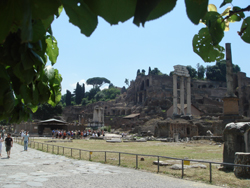Construction of the Cathedral of St Nicholas started in 1283.
The Cathedral is build on a the site of a chapel of the Romanesque
style which pre-dated the town's foundation in 1157. Construction
was completed in around 1430 and the west tower was completed
in 1490.
The church began life as a parish church. In 1512, the Church
attained the rank of Collegiate Church with a provost (with
mitre and crozier) dean, chanter and twelve canons.
In 1945 it became the Cathedral of the diocese of
Lausanne
,
Geneva
and Fribourg.
Since 1803, the Church has been the property of the state
of Fribourg and services are administered by the Roman Catholic
Church.
Art and Architecture of St Nicholas
The Cathedral of St Nicholas represents three diferent periods
of western art and architecture. The edifice of the building
is from the Gothic period
- as is the choir gate, the baptismal fonts, the pulpit, the
cross, 'The Burial of Christ' and two sculptured portals.
The chevet, the choir arch with key-stones, coats of arms
of Patrician families, decoration of the aisle archways, the
organ of Sebald Manderscheidt and the six chapels between the
butresses are from the Baroque period.
The organ of Aloys Mooser (1828/1834), the stained-glass windows
of Jozef Mehoffer (1896/1936), the stained-glass windows of
ALfred Manessier (1976/1988), the alta, ambon, the easter candlestick
and the Episcopal seat of Georges Schneider (1981/1986) and
the Millennium cross of Nuccio Fontanella (1999) all date from
the modern period.
The Cathedral of St Nicholas has 13
bells - eleven of which are in the west tower and 2 are
in the Bell Tower of the Choir.
 My personal advise on what to do and see in Rome
My personal advise on what to do and see in Rome
 Mt Egmont seen from the King Edward Park playing fields in Stratford
Mt Egmont seen from the King Edward Park playing fields in Stratford
 The Stratford Glockenspeil in Taranaki
The Stratford Glockenspeil in Taranaki
 The Antelope - your local, dog friendly, beer friendly pub
The Antelope - your local, dog friendly, beer friendly pub
 Must see ancient monuments around Rome
Must see ancient monuments around Rome
 Historical information about the gothic Antwerp Cathedral
Historical information about the gothic Antwerp Cathedral
 What to see, where to stay and eat in historic Antwerp
What to see, where to stay and eat in historic Antwerp
 Recommended hotels in Vienna, Salzburg and Bregenz
Recommended hotels in Vienna, Salzburg and Bregenz